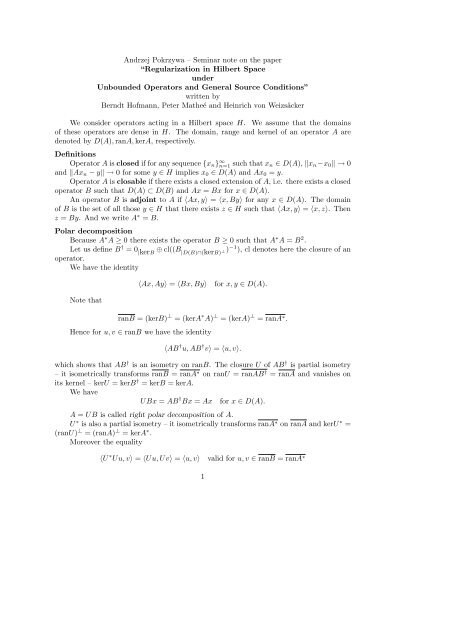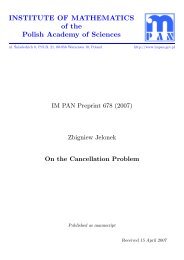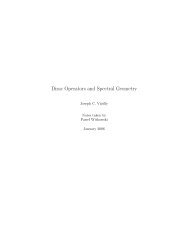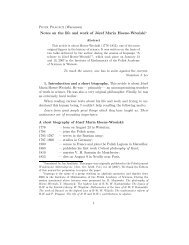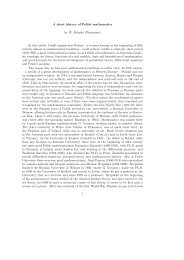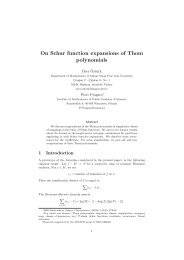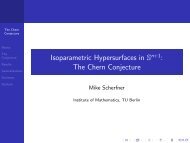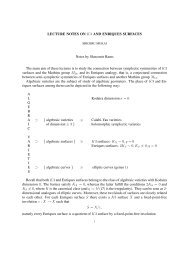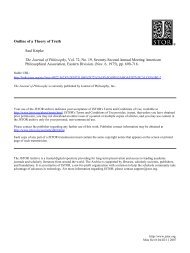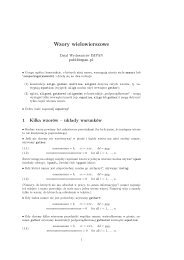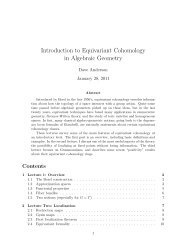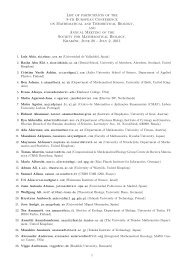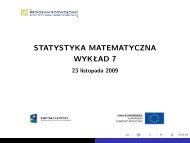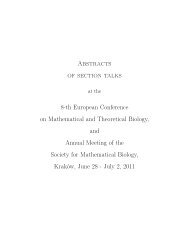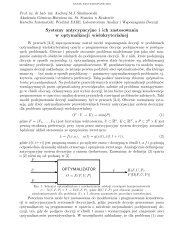About Regularization in Hilbert Space
About Regularization in Hilbert Space
About Regularization in Hilbert Space
Create successful ePaper yourself
Turn your PDF publications into a flip-book with our unique Google optimized e-Paper software.
Andrzej Pokrzywa – Sem<strong>in</strong>ar note on the paper<br />
“<strong>Regularization</strong> <strong>in</strong> <strong>Hilbert</strong> <strong>Space</strong><br />
under<br />
Unbounded Operators and General Source Conditions”<br />
written by<br />
Berndt Hofmann, Peter Matheé and He<strong>in</strong>rich von Weizsäcker<br />
We consider operators act<strong>in</strong>g <strong>in</strong> a <strong>Hilbert</strong> space H. We assume that the doma<strong>in</strong>s<br />
of these operators are dense <strong>in</strong> H. The doma<strong>in</strong>, range and kernel of an operator A are<br />
denoted by D(A), ranA, kerA, respectively.<br />
Def<strong>in</strong>itions<br />
Operator A is closed if for any sequence {xn} ∞ n=1 such that xn ∈ D(A), xn−x0 → 0<br />
and Axn − y → 0 for some y ∈ H implies x0 ∈ D(A) and Ax0 = y.<br />
Operator A is closable if there exists a closed extension of A, i.e. there exists a closed<br />
operator B such that D(A) ⊂ D(B) and Ax = Bx for x ∈ D(A).<br />
An operator B is adjo<strong>in</strong>t to A if 〈Ax, y〉 = 〈x, By〉 for any x ∈ D(A). The doma<strong>in</strong><br />
of B is the set of all those y ∈ H that there exists z ∈ H such that 〈Ax, y〉 = 〈x, z〉. Then<br />
z = By. And we write A ∗ = B.<br />
Polar decomposition<br />
Because A ∗ A ≥ 0 there exists the operator B ≥ 0 such that A ∗ A = B 2 .<br />
Let us def<strong>in</strong>e B † = 0 |kerB ⊕ cl((B |D(B)∩(kerB) ⊥) −1 ), cl denotes here the closure of an<br />
operator.<br />
We have the identity<br />
Note that<br />
〈Ax, Ay〉 = 〈Bx, By〉 for x, y ∈ D(A).<br />
ranB = (kerB) ⊥ = (kerA ∗ A) ⊥ = (kerA) ⊥ = ranA ∗ .<br />
Hence for u, v ∈ ranB we have the identity<br />
〈AB † u, AB † v〉 = 〈u, v〉.<br />
which shows that AB † is an isometry on ranB. The closure U of AB † is partial isometry<br />
– it isometrically transforms ranB = ranA ∗ on ranU = ranAB † = ranA and vanishes on<br />
its kernel – kerU = kerB † = kerB = kerA.<br />
We have<br />
UBx = AB † Bx = Ax for x ∈ D(A).<br />
A = UB is called right polar decomposition of A.<br />
U ∗ is also a partial isometry – it isometrically transforms ranA ∗ on ranA and kerU ∗ =<br />
(ranU) ⊥ = (ranA) ⊥ = kerA ∗ .<br />
Moreover the equality<br />
〈U ∗ Uu, v〉 = 〈Uu, Uv〉 = 〈u, v〉 valid for u, v ∈ ranB = ranA ∗<br />
1
shows that<br />
U ∗ Uu =<br />
u for u ∈ ranA ∗ ,<br />
0 for u ∈ kerA.<br />
Therefore A = UBU ∗ U = CU, where C = UBU ∗ is also a selfadjo<strong>in</strong>t nonnegative operator.<br />
This is the left polar decomposition of A. Note that U is the same <strong>in</strong> both polar<br />
decompositions. The above <strong>in</strong> particullary implies that AA ∗ = UB 2 U ∗ = U(A ∗ A)U ∗ .<br />
Examples.<br />
Let H = L 2 (0, 1) and A be the differentiation operator Ax(t) = x ′ (t). D(A) = {x ∈<br />
H such that x ′ ∈ H}. A is closed. What is A ∗ ? The equality<br />
<br />
〈Ax, y〉 =<br />
x ′ <br />
¯y = −<br />
x¯y ′ + (x¯y)| 1 0<br />
shows that if supp y ⊂ (0, 1) then A ∗ y = −y ′ , and that for y ∈ D(A ∗ ) we should have<br />
additionally y(0) = y(1).<br />
Thus<br />
A ∗ y = −y ′ , D(A ∗ ) = {x ∈ H; x ′ ∈ H, x(0) = x(1) = 0}.<br />
We can easily see, that AA ∗ y = −y ′′ and A ∗ Ay = −y ′′ , However doma<strong>in</strong>s of these<br />
operators differ.<br />
D(AA ∗ ) = {x ∈ H; x ′′ ∈ H and x(0) = x(1) = 0},<br />
D(A ∗ A) = {x ∈ H; x ′′ ∈ H and x ′ (0) = x ′ (1) = 0}.<br />
The operator AA ∗ has eigenfunctions s<strong>in</strong> kπx, with eigenvalues k 2 π 2 , k = 1, 2, . . .,<br />
The operator A ∗ A has eigenfunctions cos kπx, with eigenvalues k 2 π 2 , k = 0, 1, 2, . . ., all<br />
these eigenfunctions have norm 1 √ 2 except cos 0πx, which has norm 1. Thus sett<strong>in</strong>g sk =<br />
sk(x) = √ 2 s<strong>in</strong> kπx, ck = ck(x) = √ 2 cos kπx, k = 1, 2, . . . and c0 = 1 we have expansions:<br />
Def<strong>in</strong><strong>in</strong>g<br />
AA ∗ =<br />
B =<br />
∞<br />
k=1<br />
U =<br />
k 2 π 2 〈·, sk〉sk, A ∗ A =<br />
∞<br />
kπ〈·, sk〉sk, C =<br />
k=1<br />
k=1<br />
∞<br />
k=1<br />
k 2 π 2 〈·, ck〉ck<br />
∞<br />
kπ〈·, ck〉ck,<br />
k=1<br />
∞<br />
∞<br />
〈·, sk〉ck, V = − 〈·, ck〉sk,<br />
we have AA ∗ = B 2 , A ∗ A = C 2 with nonnegative selfadjo<strong>in</strong>t operators B, C.<br />
We have also Ack = −kπsk = BV ck = V Cck, and A ∗ sk = −kπck = −CUsk =<br />
−UBsk<br />
2<br />
k=1
Now it is easy to see that we have polar decompositions:<br />
A = BV = V C, A ∗ = −CU = −UB.<br />
U is an isometry, but its range is not all H, V is partial isometry with kernel spanned by<br />
c0. Here U ∗ = −V .<br />
The operator A has a lot of eigenfunctions, namely any function e λx with complex<br />
number λ is its eigenfunction. From this set of eigenfunctions we may get a subset, which<br />
forms an orthonormal basis of H, for example ek = ek(x) = e 2πkxi , k = 0, ±1, ±2, . . ..<br />
Hence one may write<br />
A = 2πi<br />
∞<br />
k〈·, ek〉ek,<br />
−∞<br />
and such equality implies that A is a normal operator, with polar decompositions A =<br />
U0B0 = B0U0, where<br />
∞<br />
∞<br />
B0 = 2π |k|〈·, ek〉ek, U0 = i signk〈·, ek〉ek.<br />
−∞<br />
Of course it contradicts our previus considerations. What is wrong? We have choosen<br />
a basis which consists from periodic functons, as a derivative of a periodic function is aga<strong>in</strong><br />
periodic we have silently restricted the doma<strong>in</strong> of A to periodic functions only. Thus the<br />
operator A with the above expansion this time has a doma<strong>in</strong> {x ∈ H; x ′ ∈ H, x(0) = x(1)}.<br />
A similar efect happens, when one tries to use s<strong>in</strong>e basis (sk) for approximation operator<br />
A. This shows that one has to be carefull while approximat<strong>in</strong>g unbounded operators.<br />
Stone–von Neumann operator calculus<br />
Operator calculus enables us to def<strong>in</strong>e f(A), where f is a complex valued functions<br />
def<strong>in</strong>ed on a subset of the complex plane, and A an operator. If f is a polynomial f(A)<br />
expands <strong>in</strong> powers of A <strong>in</strong> the same way as the polynomial.<br />
In the case when A is a diagonalizable operator, i.e. A = λj〈·, ek〉ek we set f(A) =<br />
f(λj)〈·, ek〉ek and this def<strong>in</strong>iton is consistent with the def<strong>in</strong>ition for polynomials.<br />
Def<strong>in</strong><strong>in</strong>g functions of selfadjo<strong>in</strong>t operators is nearly the same task as that for diagonal<br />
ones. Let µ be a nonnegative Borel mesure def<strong>in</strong>ed on Borel subsets of real l<strong>in</strong>e. Let<br />
H = L 2 (µ), and A be an operator def<strong>in</strong>ed by Ax(t) = tx(t). This operator is selfadjo<strong>in</strong>t,<br />
its spectrum co<strong>in</strong>cides with the support of µ, and for any Borel function f the operator<br />
f(A) is def<strong>in</strong>ed by f(A)x(t) = f(t)x(t).<br />
Operators of this k<strong>in</strong>d are blocks from which any selfadjo<strong>in</strong>t operator is composed.<br />
Namely, if A is a selfadjo<strong>in</strong>t operator act<strong>in</strong>g <strong>in</strong> a <strong>Hilbert</strong> space H then there exists a family<br />
{µα}α of nonnegative Borel measures and a unitary operator U : H → ⊕αL 2 (µα) such<br />
that A = U ∗ ⊕α AαU, where Aαx(t) = tx(t).<br />
It is well known that spectral measure is a useful tool for study<strong>in</strong>g selfadjo<strong>in</strong>t operators.<br />
For each Borel subset Ω ⊂ R is an orthogonal projection act<strong>in</strong>g <strong>in</strong> H. Spectral measure<br />
has properties similar to measure, E(Ω) is an orthogonal projection <strong>in</strong> H, E(Ω1)E(Ω2) =<br />
3<br />
−∞
E(Ω1 ∩ Ω2), E(∅) = 0, E(R) = I. Moreover E(Ω)A = AE(Ω), and the operator A and<br />
any Borel measureable function f of this opeator may be expressed as<br />
<br />
A =<br />
<br />
tdE, f(A) =<br />
f(t)dE.<br />
if ess sup |f| = sup t≥0{t : E({x : |f(x)| ≥ t}) = 0} is bounded, then this quantity equals<br />
f(A), if it is unbounded the operator f(A) is unbounded.<br />
With the representation of A as the direct sum of operatores we can write<br />
E(Ω)x = U ∗ ⊕α χ(Ω)xαU,<br />
where χ(Ω) is the charecteristic function of the set Ω.<br />
Note also that σ(A) = supp E = <br />
α supp µα<br />
While <strong>in</strong>vestigat<strong>in</strong>g the proofs of the result of the paper, we can see that the most<br />
essentiall parts are those which refer to properties of a selfadjo<strong>in</strong>t operator. We shall give<br />
the proofs <strong>in</strong> the case when H = L2 (µ), and A is def<strong>in</strong>ed by Ax(t) = tx(t). We shall refer<br />
to this case as the model case. For some results we will present also a proof <strong>in</strong> the general<br />
case. All the others may be modified similarily.<br />
We shall use result number<strong>in</strong>g as <strong>in</strong> the orig<strong>in</strong>al paper, chang<strong>in</strong>g sometimes notations.<br />
Index function def<strong>in</strong>ition A positive function ψ : (0, ∞) → (0, ∞) is an <strong>in</strong>dex function<br />
if it is <strong>in</strong>creas<strong>in</strong>g (non-decreas<strong>in</strong>g) and cont<strong>in</strong>uous with limt→0 ψ(t) = 0.<br />
Theorem 1. Let A be a nonnegative selfadjo<strong>in</strong>t operator act<strong>in</strong>g <strong>in</strong> H with kerA = {0}.<br />
then<br />
(a) For every x ∈ H and ε > 0 there exists a bounded <strong>in</strong>dex function ψ such that the<br />
general source condition<br />
x = ψ(A)w with w ∈ H and w ≤ (1 + ε)x<br />
is satisfied, and hence x ∈ ranψ(A).<br />
(b) If x ∈ ranψ(A) for some unbounded <strong>in</strong>dex function ψ, then x ∈ ranψ0(A) for every<br />
bounded <strong>in</strong>dex function ψ0 which co<strong>in</strong>cides with ψ on (0, t0] for some t0 > 0.<br />
Comment 1. Why there is w ≤ (1 + ε)x above? – substitut<strong>in</strong>g ψ with ψε = 1+ε<br />
ε ψε<br />
and w by wε = ε<br />
1+εw we get estimation w ≤ εx, while theorem suggests that the<br />
constant 1 and any smaller one cannot be achived. However I suppose thay have some<br />
good reason for it, for example the family of <strong>in</strong>dex function ψγ(t) = γψ(t) γ > 0 should<br />
be represented by this one, that ψγ(¯α) = 1.<br />
Proof of Th. 1 part (a) – model case version We assume H = L2 (µ), Ax(t) = tx(t)<br />
and x = 1. We have x 2 = ∞<br />
0 |x(t)| 2 dµ = 1, therefore for any α ∈ (0, 1) there exists<br />
decreas<strong>in</strong>g and converg<strong>in</strong>g to 0 sequence of numbers {τn} ∞ n=0 such that<br />
<br />
|x(t)|<br />
(0,τn)<br />
2 dµ ≤ εα n , for n = 0, 1, . . . .<br />
4
and<br />
Def<strong>in</strong>e with β > 1 and such that αβ2 < 1<br />
<br />
1 for t ≥ τ0<br />
ψ0(t) =<br />
β−n for t ∈ [τn, τn−1),<br />
, .<br />
n = 1, 2, . . .<br />
(1)<br />
Then <br />
ψ −1<br />
0 (A)x2 <br />
=<br />
[τn,τn−1)<br />
<br />
=<br />
(0,∞)<br />
[τ0,∞)<br />
≤1 + ε<br />
α<br />
Thus with α = 1<br />
4 , β2 = 4<br />
3 (then<br />
therefore w = ψ −1<br />
0<br />
|ψ −1<br />
0 (t)x(t)|2 dµ ≤ εβ 2n α n−1<br />
|ψ −1<br />
0 (t)x(t)|2 dµ<br />
|x(t)| 2 dµ +<br />
∞<br />
n=1<br />
∞<br />
<br />
n−1<br />
(αβ 2 ) n = 1 + ε<br />
[τn,τn−1)<br />
β2 .<br />
1 − αβ2 |ψ −1<br />
0 (t)x(t)|2 dµ<br />
β 2<br />
1−αβ 2 = 2) we have ψ −1<br />
0 (A)x ≤ √ 1 + 2ε < 1 + ε and<br />
(A)x satisfies the thesis (part (a)).<br />
If we require ψ to be a cont<strong>in</strong>uous function we may def<strong>in</strong>e it as a cont<strong>in</strong>uous piecewise<br />
l<strong>in</strong>ear function, l<strong>in</strong>ear <strong>in</strong> <strong>in</strong>tervals [τn, τn−1] and such that ψ(τn) = ψ0(τn). Then<br />
ψ0(t) ≥ ψ(t) and ψ −1 (A)x 2 = |ψ −1 (t)x(t)| 2 ≤ |ψ −1<br />
0 (t)x(t)|2 = ψ −1<br />
0 (A)x2 and the<br />
thesis is satisfied for ψ.<br />
Proof of Th. 1 part (a) – general version Let E be spectral measure for operator<br />
A, ε > 0 and α = 1<br />
4 . We can f<strong>in</strong>d decreas<strong>in</strong>g and converg<strong>in</strong>g to 0 sequence of numbers<br />
we have<br />
{τn} ∞ n=0 such that E((0, τn))x 2 < εα n . With ψ0 def<strong>in</strong>ed by (1) and β 2 = 4<br />
3<br />
we have<br />
Because<br />
ψ −1<br />
0 (A)x2 =<br />
∞<br />
n=1<br />
∞<br />
n=1<br />
ψ0(τn) −1 E([τn, τn−1)x 2 ≤ εα n−1 β 2n<br />
ψ −1<br />
0 (τn) −1 E([τn, τn−1) + E((τ0, ∞)) = ψ −1<br />
0 (A)<br />
ψ −1<br />
0 (τn) −1 E([τn, τn−1)x 2 + E((τ0, ∞))x 2 < 1 + 2ε < (1 + ε) 2<br />
Thus w = ψ −1<br />
0 (A)x satisfies part (a) of the thesis.<br />
Proof of part (b). Assume H = L2 (µ) and action of A on a function is its multiplication<br />
by the argument. Then<br />
ψ0f 2 =<br />
<br />
<br />
≤<br />
(0,t0)<br />
(0,t0)<br />
<br />
+ |ψ0(t)f(t)|<br />
[t0,∞)<br />
2<br />
|ψ(t)f(t)| 2 + sup ψ<br />
t<br />
2 <br />
0(t)<br />
5<br />
[t0,∞)<br />
|f(t)| 2 ≤ ψf 2 + sup ψ<br />
t<br />
2 0(t)f 2 .
In the general case, with each nonzero x ∈ H we may associate Borel measure on the<br />
l<strong>in</strong>e by µ(Ω) = E(Ω)x2 . For any Borel measureable funciton ψ we then have<br />
ψ(A)x 2 <br />
= ψ(t)xdE 2 <br />
= ψ(t)xdE 2 <br />
= |ψ(t)| 2 xdE 2 <br />
= |ψ(t)| 2 dµ.<br />
The proof is analogous to the proof for H = L 2 (µ) with f = f(t) = 1.<br />
<strong>Regularization</strong> def<strong>in</strong>ition. Family {gα}0 0.<br />
Approximate solution of equation Ax = y is def<strong>in</strong>ed as<br />
where y δ − y ≤ δ.<br />
x δ α = A ∗ gα(AA ∗ )y δ<br />
Source condition for the solution x † of the equation Ax = y is x † = ψ(A ∗ A)w.<br />
Def<strong>in</strong>ition<br />
W = {g : gW = sup<br />
s∈R +<br />
√<br />
s|g(s)| < ∞}<br />
Proposition 1. If g ∈ W then A ∗ g(AA ∗ ) = g(A ∗ A)A ∗ and A ∗ g(AA ∗ ) ≤ gW .<br />
In the space H = L 2 (µ) proposition takes the form<br />
and becomes trivial.<br />
Corollary 2. With rα(t) = 1 − tgα(t)<br />
sup |tg(t<br />
t>0<br />
2 )| ≤ gW<br />
rα(A ∗ A) ≤ γ1, A ∗ gα(AA ∗ ) ≤ γ∗<br />
√α .<br />
Proof. In our model case the thesis reads as<br />
sup<br />
t>0<br />
|1 − t 2 gα(t 2 )| ≤ γ1, sup |tgα(t<br />
t>0<br />
2 )| ≤ γ∗<br />
√α ,<br />
so there is noth<strong>in</strong>g to prove, as this is equivalent with def<strong>in</strong>itions.<br />
In the general case let A = BU be polar decomposition of A and E be spectral measure<br />
for B ≥ 0, then A ∗ A = U ∗ B 2 U, AA ∗ = B 2 and<br />
rα(A ∗ A) = U ∗<br />
<br />
rα(t 2 )dEU, A ∗ gα(AA ∗ ) = U ∗<br />
6<br />
<br />
tg(t 2 )dE.
Thesis follows form the fact that rα(A ∗ A) = ess sup t∈σ(A ∗ A)|rα(t)| ≤ γ1 and similarily<br />
for A ∗ gα(AA ∗ ).<br />
Lemma 6. With xα = A ∗ gα(AA ∗ )Ax † = A ∗ gα(AA ∗ )y we have<br />
xα − x δ α ≤ γ∗<br />
δ<br />
√ .<br />
α<br />
Proof. In the model case xα(t) = tgα(t 2 )y(t). Therefore<br />
|xα(t) − x δ α(t)| = |tgα(t 2 )(y(t) − y δ (t))| ≤ sup |tgα(t<br />
t>0<br />
2 )||y(t) − y δ (t))| ≤ γ∗<br />
√α |y(t) − y δ (t)|<br />
and this implies the thesis.<br />
In the general case let BU = A be polar decomposition of A, and E be spectral<br />
measure for B. Then xα = U ∗ Bgα(B 2 )y, x δ α = U ∗ Bgα(B 2 )y δ and<br />
and because<br />
xα − x δ α = U ∗ Bgα(B 2 )(y − y δ )<br />
Bgα(B 2 <br />
) =<br />
where E is the spectral measure of B, we have<br />
and f<strong>in</strong>ally<br />
tgα(t 2 )dE<br />
Bgα(B 2 ) ≤ sup t|gα(t<br />
t>0<br />
2 )| ≤ γ∗<br />
√α<br />
xα − x δ α = U ∗ Bgα(B 2 )y ≤ U ∗ Bgα(B 2 )y − y δ ≤ γ∗<br />
√α y − y δ .<br />
Lemma 7. If the solution x † satisfies source condition x † = ψ(A ∗ A)w then<br />
Proof. In the model case<br />
Hence<br />
x † − xα ≤ w sup<br />
s∈σ(A∗A) |rα(s)|ψ(s).<br />
x † (t) − xα(t) = ψ(t 2 )w(t) − t 2 gα(t 2 )ψ(t 2 )w(t) = ψ(t 2 )(1 − t 2 gα(t 2 ))w(t).<br />
x † − xα ≤ sup |ψ(t<br />
t∈supp µ<br />
2 )rα(t 2 )| · w.<br />
Now the thesis follows form the fact that σ(A 2 ) = {t 2 : t ∈ σ(A)} and <strong>in</strong> the model case<br />
σ(A) = supp µ.<br />
7
In the general case with the notation used <strong>in</strong> proof of Lemma 6 we have A ∗ A =<br />
U ∗ BBU and therefore<br />
x † = ψ(A ∗ A)w = U ∗ ψ(B 2 )Uw,<br />
,<br />
Thus<br />
Note that<br />
xα =U ∗ Bgα(B 2 )y = U ∗ Bgα(B 2 )Ax †<br />
=U ∗ Bgα(B 2 )BUU ∗ ψ(B 2 )Uw = U ∗ B 2 gα(B 2 )ψ(B 2 )Uw<br />
x † − xα = U ∗ (I − B 2 gα(B 2 ))ψ(B 2 )Uw. (2)<br />
(I − B 2 gα(B 2 ))ψ(B 2 ) =<br />
<br />
(1 − t 2 gα(t 2 ))ψ(t 2 )dE<br />
(I − B 2 gα(B 2 ))ψ(B 2 ) ≤ sup |1 − t<br />
t∈σ(B)<br />
2 gα(t 2 )|ψ(t 2 ) = sup<br />
t∈σ(A∗ |r(t)|ψ(t), (3)<br />
A)<br />
because σ(A ∗ A) may differ from σ(AA ∗ ) = σ(B 2 ) only by 0, and by the spectral mapp<strong>in</strong>g<br />
theorem σ(B 2 ) = {t 2 ; t ∈ σ(B)}.<br />
Because U = U ∗ = 1 (2) and (3) imply the thesis.<br />
From Lemmata 6 and 7 we get f<strong>in</strong>al estimation<br />
x † − x δ α ≤ x † − xα + xα − x δ α ≤ w sup<br />
s<br />
Bias convergence. Us<strong>in</strong>g the notation of Lemma 6 we have<br />
and<br />
δ<br />
|rα(s)|ψ(s) + γ∗ √ . (4)<br />
α<br />
x † − xα =x † − A ∗ gα(AA ∗ )Ax † = U ∗ Ux † − U ∗ Bgα(B 2 )BUx †<br />
=U ∗ (I − B 2 gα(B 2 ))Ux † = U ∗ rα(B 2 )Ux †<br />
x † − xα 2 =<br />
<br />
r 2 α(t 2 )dEUx † 2 .<br />
(dEUx † 2 = dµ where the measure µ is def<strong>in</strong>ed by µ(Ω) = E(Ω)Ux † 2 .) The convergence<br />
x † − xα → 0 follows form def<strong>in</strong>ition of regularization (parts a) and b)) and the<br />
Lebesgue’s dom<strong>in</strong>ated convergence theorem.<br />
Qualification<br />
Def<strong>in</strong>ition 2. Qualification def<strong>in</strong>ition An <strong>in</strong>dex function ϕ is a qualification of the<br />
regularisation gα if there are constants γ = γϕ < ∞, ¯αϕ such that<br />
sup<br />
s∈σ(A∗A) |rα(s)|ϕ(s) ≤ γϕ(α), 0 < α ≤ ¯αϕ. (5)<br />
Usually we do not know σ(A ∗ A) which appears <strong>in</strong> (5), all we know is that σ(A ∗ A) ⊂<br />
[0, ∞), moreover qualification function is not def<strong>in</strong>ed <strong>in</strong> 0, therefore (5) should be read as<br />
sup |rα(s)|ϕ(s) ≤ γϕ(α), 0 < α ≤ ¯α. (5<br />
s>0<br />
′ )<br />
8
Proposition 2. (reformulated) Let gα be a regularization with some known qualification<br />
ϕ. If ψ is an <strong>in</strong>dex function such that<br />
there exists s0 > 0 such that the function s → ψ(s)/ϕ(s), 0 < s ≤ s0 is non-<strong>in</strong>creas<strong>in</strong>g,<br />
then ψ is a qualification of gα.<br />
ψ(s) ≤ Cϕ(s) for s > s0 (GC)<br />
Proof. If s ≤ α then ψ(s) ≤ ψ(α) and by <strong>Regularization</strong> def<strong>in</strong>ition (b)<br />
We have<br />
If α ≤ s ≤ s0 then<br />
This and (a2) show that<br />
We write (a2) <strong>in</strong> the form<br />
If α ≤ s0 then<br />
Therefore<br />
|rα(s)|ψ(s) ≤ γ1ψ(α) for s ≤ α. (a1)<br />
|rα(s)|ψ(s) = |rα(s)|ϕ(s) ψ(s)<br />
ϕ(s)<br />
ψ(s)<br />
ϕ(s)<br />
≤ ψ(α)<br />
ϕ(α) .<br />
≤ γϕϕ(α) ψ(s)<br />
ϕ(s)<br />
(a2)<br />
|rα(s)|ψ(s) ≤ γϕϕ(α) ψ(α)<br />
ϕ(α) = γϕψ(α) if α ≤ s ≤ s0 (a3)<br />
ψ(s0)<br />
ϕ(s0)<br />
|rα(s)|ψ(s) ≤ γϕψ(α) ϕ(α) ψ(s)<br />
ψ(α) ϕ(s) .<br />
≤ ψ(α)<br />
ϕ(α)<br />
If s ≥ s0 then ψ(s) ≤ Cϕ(s) and<br />
or equivalently ϕ(α)<br />
ψ(α)<br />
|rα(s)|ψ(s) ≤ γϕψ(α) ϕ(s0) ψ(s)<br />
ψ(s0) ϕ(s)<br />
≤ ϕ(s0)<br />
ψ(s0)<br />
if α ≤ s0<br />
ϕ(s0)<br />
|rα(s)|ψ(s) ≤ Cγϕ<br />
ψ(s0) ψ(α) if α ≤ s0 and s ≥ s0. (a4)<br />
The <strong>in</strong>equalities (a1), (a2) and (a4) show that ψ is a qualification for gα with constants<br />
¯αψ = m<strong>in</strong>{¯α, s0} γψ = m<strong>in</strong>{Cγϕ ϕ(s0)<br />
ψ(s0) , γϕ, γ1}.<br />
Remark. It is easy to show, that if condition (GC) holds for some s0 then it holds for<br />
any s0 > 0, the constant C may change only. However s0 appears also <strong>in</strong> the assumption<br />
9
on the monotonicity of ψ(s)<br />
ϕ(s) . Thus we cannot ignore the constant ¯αψ as the authors of the<br />
paper have done.<br />
Proposition 3. (reformulated) Let gα be a regularization with some known qualification<br />
ϕ. If ψ is an <strong>in</strong>dex function such that<br />
there exists s0 > 0 such that the function s → ψ(s)/ϕ(s), 0 < s ≤ s0 is non-decreas<strong>in</strong>g,<br />
and (GC) holds. then<br />
Proof.(omited by th authors) We have<br />
hence from (a2) it follows that<br />
On the other hand<br />
then aga<strong>in</strong> form (a2) we have<br />
|rα(s)|ψ(s) ≤ Cϕ(α) for α ∈ (0, ¯α), s > 0.<br />
ψ(s)<br />
ϕ(s)<br />
≤ ψ(s0)<br />
ϕ(s0)<br />
|rα(s)|ψ(s) ≤ γϕϕ(α) ψ(s)<br />
ϕ(s)<br />
for s ≤ s0,<br />
≤ γϕϕ(α) ψ(s0)<br />
ϕ(s0)<br />
ψ(s) ≤ Cϕ(s) for s > s0,<br />
for s ≤ s0. (a5)<br />
|rα(s)|ψ(s) ≤ γϕϕ(α) ψ(s)<br />
ϕ(s) ≤ Cγϕϕ(α) for s > s0. (a6)<br />
The thesis follows form (a5) and (a6) with C replaced by γϕ max{C, ψ(s0)<br />
ϕ(s0) }.<br />
Comment 2. In the orig<strong>in</strong>al formulation of the above proposition authors claim that<br />
1 ≤ C ≤ ∞. There is no reason for it – if ψ satisfies the thesis with C then 1<br />
2C ϕ satisfies<br />
the assumptions and the thesie with C = 1<br />
2 . See Comment 1.<br />
Lemma 7 and Propositions 2 and 3 lead to bias estimation.<br />
Proposition 4. Let gα be a regularization with qualification ϕ and x † = ψ(A ∗ A)w a<br />
source condition with <strong>in</strong>dex function ψ, which satisfies (GC).<br />
a) If the function ψ(s)<br />
ϕ(s) is non-<strong>in</strong>creas<strong>in</strong>g <strong>in</strong> (0, s0] then for some C, ¯α > 0<br />
x † − xα ≤ Cψ(α)w, α ∈ (0, ¯α]<br />
b) If the function ψ(s)<br />
ϕ(s) is non-decreas<strong>in</strong>g <strong>in</strong> (0, s0] then for some C, ¯α > 0<br />
x † − xα ≤ Cϕ(α)w, α ∈ (0, ¯α]<br />
10
Remark Note that if we set<br />
ϕ0(s) = ϕ(s), ψ0(s) = ψ(s) for s ∈ (0, s0]<br />
ϕ0(s) = ϕ(s0), ψ0(s) = ψ(s0) for s ∈ (s0, ∞)<br />
then ϕ0 is also the qualification for gα (by Proposition 2) and the functions ϕ0, ψ0 satisfy<br />
the same assumptions as the functions ϕ, ψ <strong>in</strong> Propositions 2-4, therefore also the same<br />
claims for these functions hold.<br />
Convergence rates.<br />
With assumptions of Proposition 4 and Lemma 6 we get error estimates if the form<br />
x † − x δ δ<br />
α ≤ Cψ(α)w + γ∗ √ , α ∈ (0, ¯α]<br />
α<br />
x † − x δ δ<br />
α ≤ Cϕ(α)w + γ∗ √ , α ∈ (0, ¯α]<br />
α<br />
If ψ(s) = sp for each fixed δ we may f<strong>in</strong>d α = α(δ) which m<strong>in</strong>imizes the right hand<br />
side <strong>in</strong> these equalities. With such ψ or ϕ we get estimation of the form<br />
x † − x δ <br />
α ≤ C α p + cδ<br />
<br />
√ .<br />
α<br />
The m<strong>in</strong>imum is atta<strong>in</strong>ed for α =<br />
With this choice of α we get<br />
2<br />
2p+1 cδ<br />
2p<br />
and equals cδ 2p<br />
2p+1 with some new constant c.<br />
x † − x δ α ≤ Cδ 2p<br />
2p+1 .<br />
Splitt<strong>in</strong>g operator. Us<strong>in</strong>g polar decomosition and spectral measure we may split operator<br />
A = Ab ⊕ Au. Let A = BU be the polar decomposition of A, A : D(A) → H2,<br />
D(A) ⊂ H1, where H1, H2 are <strong>Hilbert</strong> spaces. B : D(B) → H2, D(B) ⊂ H2 is a positive<br />
selfadjo<strong>in</strong>t operator, and U : H1 → H2 is an isometry.<br />
With E - the spectral measure of B we set<br />
Now<br />
H2,b = E([0, s0])H2, H2,u = E((s0, ∞))H2,<br />
H1,b = U −1 H2,b, H1,u = U −1 H2,u.<br />
Ab = A|H1,b :H1,b → H2,b,<br />
Au = A|H1,u :D(Au) → H2,u, D(Au) = D(A) ∩ H1,u.<br />
In the model case H1,b = H2,b = L 2 µ([0, s0]), H1,u = H2,u = L 2 µ((s0, ∞))<br />
Ab is a bounded operator Ab ≤ s0, Au may be unbounded, however it has a bounded<br />
<strong>in</strong>verse, because for x ∈ D(Au) ⊂ H1,u we have<br />
Aux = BUx ≥ s0Ux = s0x.<br />
11
With this splitt<strong>in</strong>g regularization splits also<br />
x δ α = A ∗ gα(AA ∗ )y δ = A ∗ bgα(B 2 )y δ b ⊕ A ∗ ugα(B 2 )y δ u,<br />
where y δ b = U −1 E([0, s0])Uy δ , y δ u = U −1 E((s0, ∞))Uy δ , and therefore y δ u 2 + y δ b 2 =<br />
y δ 2 .<br />
<strong>Regularization</strong> theory for bounded operators is known it suffices to check, how it may<br />
be applied for unbounded operators with bounded <strong>in</strong>verse.<br />
If ϕ is a qualification for {gα} then for any s0 > 0<br />
|rα(ξ)|ϕ(s0) ≤ |rα(ξ)|ϕ(ξ) ≤ sup |rα(s)|ϕ(s) ≤ γϕ(α), 0 < α ≤ ¯α, ξ > s0.<br />
s>0<br />
Then we can estimate some part of bias.<br />
In the model case we have<br />
and<br />
E([s0, ∞))(x † − xα) = (I − A 2 ugα(A 2 u))E([s0, ∞))x †<br />
E([s0, ∞))(x † − xα) 2 =<br />
In the general case we have<br />
and therefore<br />
<br />
[s0,∞)<br />
|rα(t 2 ))x † (t)| 2 ≤ γ2 ϕ 2 (α)<br />
ϕ 2 (s 2 0 ) E([s0, ∞))x † 2<br />
U ∗ E([s0, ∞))U(x † − xα) = U ∗ (I − B 2 gα(B 2 ))E([s0, ∞))Ux †<br />
U ∗ E([s0, ∞))U(x † − xα) 2 =<br />
Hence<br />
<br />
[s0,∞)<br />
r 2 α(t 2 )dEUx † 2 ≤ γ2 ϕ 2 (α)<br />
ϕ 2 (s 2 0 ) E([s0, ∞))Ux † 2 .<br />
U ∗ E([s0, ∞))U(x † − xα) ≤ γϕ(α)<br />
ϕ(s 2 0 ) x† . (6)<br />
Part c) of regularization def<strong>in</strong>ition is ma<strong>in</strong>ly applicable to operators for which their<br />
positive part <strong>in</strong> polar decompsition is not strictly bounded by 0 from below. It is not the<br />
case for Au.<br />
U ∗ E([s0, ∞))U(xα − x δ α) ≤ sup t|gα(t<br />
t≥s0<br />
2 )y − y δ ≤ δ sup t|gα(t<br />
t≥s0<br />
2 ).<br />
For Tikhonov relularization gα(t) = 1<br />
t+α and<br />
sup<br />
t≥s0<br />
t|gα(t 2 ) = s0<br />
s2 ≤ s−1 0<br />
0 + α<br />
for α ≤ s 2 0<br />
because the derivative or t<br />
t 2 +α is negative for α ≤ s2 0. Thus the bound does not depend<br />
on α.<br />
References.<br />
1. Berndt Hofmann, Peter Matheé and He<strong>in</strong>rich von Weizsäcker, <strong>Regularization</strong> <strong>in</strong> <strong>Hilbert</strong><br />
<strong>Space</strong> under Unbounded Operators and General Source Conditions, Inverse Problems<br />
25 (2009), 1–15.<br />
1. T. Kato, Perturbation Theory for L<strong>in</strong>ear Operators, Spr<strong>in</strong>ger-Verlag 1976.<br />
12


